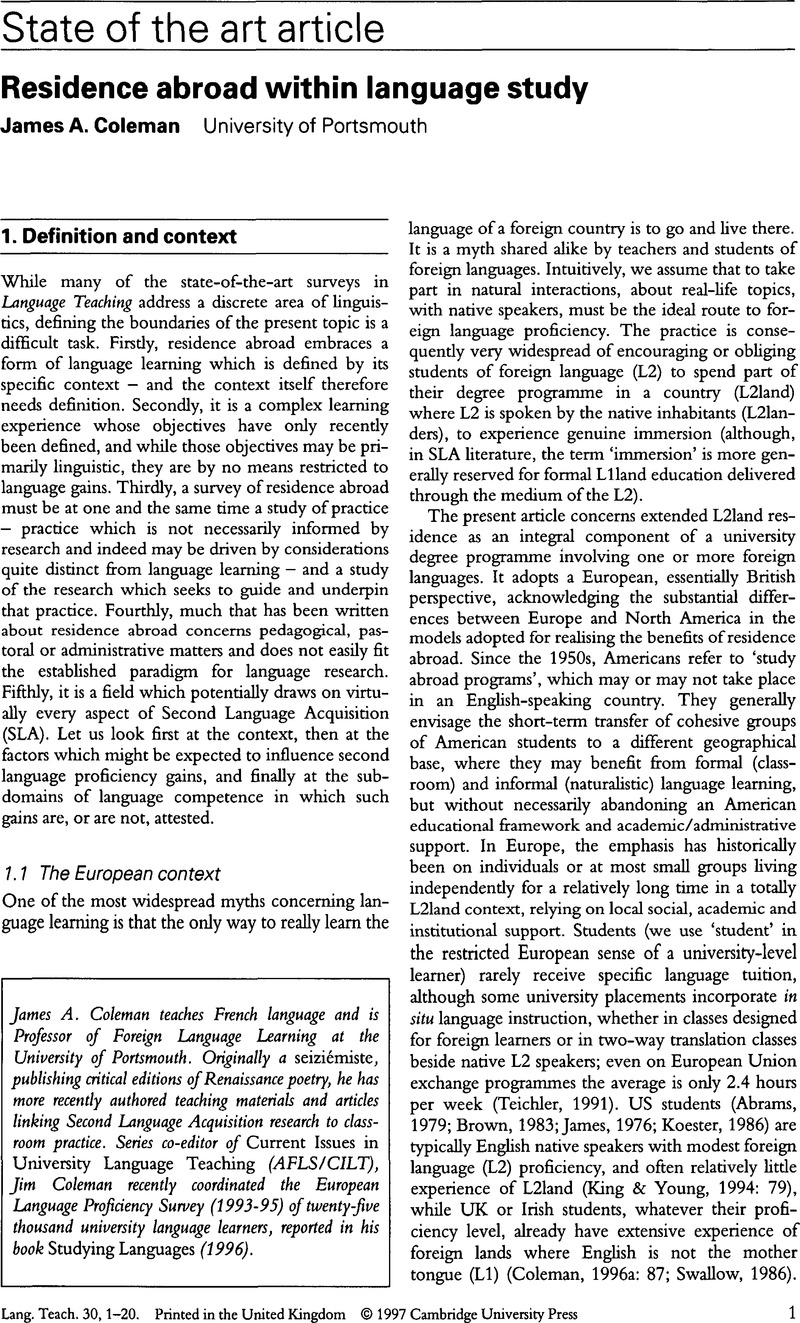Crossref Citations
This article has been cited by the following publications. This list is generated based on data provided by Crossref.
Ball, Moira
2000.
Preparing non-specialist language students for study abroad.
The Language Learning Journal,
Vol. 21,
Issue. 1,
p.
19.
Klapper, John
and
Rees, Jonathan
2003.
Reviewing the case for explicit grammar instruction in the university foreign language learning context.
Language Teaching Research,
Vol. 7,
Issue. 3,
p.
285.
Rees, Jonathan
and
Klapper, John
2005.
International Relations.
Vol. 3,
Issue. ,
p.
67.
Taillefer, Gail
2005.
Reading for academic purposes: the literacy practices of British, French and Spanish Law and Economics students as background for study abroad.
Journal of Research in Reading,
Vol. 28,
Issue. 4,
p.
435.
Howard, Martin
2005.
L’acquisition de la liaison en français langue seconde.
Corela,
Howard, Martin
2005.
On The Role Of Context In The Development Of Learner Language.
ITL - International Journal of Applied Linguistics,
Vol. 147-148,
Issue. ,
p.
1.
TAILLEFER, GAIL F.
2005.
Foreign Language Reading and Study Abroad: Cross-Cultural and Cross-Linguistic Questions.
The Modern Language Journal,
Vol. 89,
Issue. 4,
p.
503.
Barkhuizen, Gary
and
Feryok, Anne
2006.
Pre‐Service Teachers' Perceptions of a Short‐Term International Experience Programme.
Asia-Pacific Journal of Teacher Education,
Vol. 34,
Issue. 1,
p.
115.
Magnan, Sally Sieloff
and
Back, Michele
2007.
Social Interaction and Linguistic Gain During Study Abroad.
Foreign Language Annals,
Vol. 40,
Issue. 1,
p.
43.
Barron, Anne
and
Warga, Muriel
2007.
Acquisitional pragmatics: Focus on foreign language learners.
Intercultural Pragmatics,
Vol. 4,
Issue. 2,
Lee, Dong-Eun
and
Lee, Jin-Hwa
2008.
미국 내 한국어 프로그램과 한국 현지 프로그램 간의 연계를 위한 요구 분석.
The Korean Society of Bilingualism,
Vol. 38,
Issue. ,
p.
341.
Cecilia Nagy, Borbala
2008.
Linguistic and Socio-Cultural Outcomes of theAu PairExperience in the United Kingdom.
Language and Intercultural Communication,
Vol. 8,
Issue. 3,
p.
172.
Chik, Alice
2008.
Native English-speaking Students in Hong Kong EFL Classrooms: A Case Study.
Innovation in Language Learning and Teaching,
Vol. 2,
Issue. 1,
p.
18.
Chik, Alice
2008.
Native English-speaking Students in Hong Kong EFL Classrooms: A Case Study.
Innovation in Language Learning and Teaching,
Vol. 2,
Issue. 1,
p.
18.
KINGINGER, CELESTE
2008.
Language Learning in Study Abroad: Case Studies of Americans in France.
The Modern Language Journal,
Vol. 92,
Issue. s1,
p.
1.
Tuncer, Ufuk
2009.
How do monolingual and bilingual language learners differ in use of learning strategies while learning a foreign language? Evidences from Mersin University.
Procedia - Social and Behavioral Sciences,
Vol. 1,
Issue. 1,
p.
852.
Jinghui Liu, Jack
2010.
Assessing Students’ Language Proficiency.
Journal of Studies in International Education,
Vol. 14,
Issue. 5,
p.
528.
Kinginger, Celeste
2010.
American students abroad: Negotiation of difference?.
Language Teaching,
Vol. 43,
Issue. 2,
p.
216.
Kinginger, Celeste
2011.
Enhancing Language Learning in Study Abroad.
Annual Review of Applied Linguistics,
Vol. 31,
Issue. ,
p.
58.
Llanes, Àngels
2011.
The many faces of study abroad: an update on the research on L2 gains emerged during a study abroad experience.
International Journal of Multilingualism,
Vol. 8,
Issue. 3,
p.
189.


